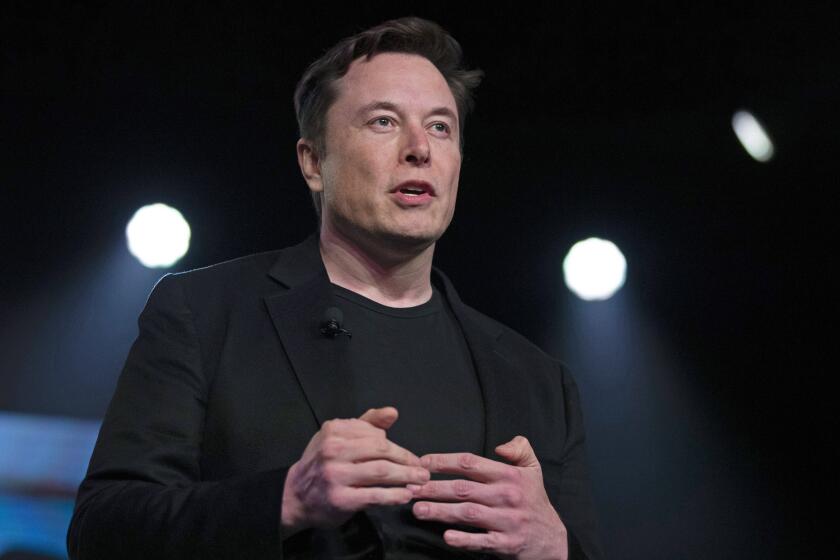Column: How Apple and other manufacturers attack your right to repair their products
- Share via
For 10 years, John Bumstead has had a small but profitable business buying old Apple laptops in bulk, refurbishing them by hand, and selling them to wholesalers or via Amazon.com for about $150.
They’re good, working machines saved from obsolescence to bring the Apple experience to buyers who can’t afford the company’s super-premium prices. “I give these computers a second life,” Bumstead told me from his home in Minneapolis.
But come Jan. 4, a big chunk of his marketplace will disappear. That’s when Amazon will close off access to its website for unauthorized Apple resellers. They have limited options: Either try to obtain reseller authorization from Apple (not an easy process), or meet Amazon’s specifications for sellers of refurbished merchandise, which include proof that they’ve sold $2.5 million in Apple goods to major retailers or wireless carriers over 90 days.
If you can’t repair stuff, you’re forced to participate in the throwaway market.
— Gay Gordon-Byrne, the Repair Assn.
“The people who’ve been selling MacBooks or other Apple products are pretty much going to be cut off from the Amazon marketplace,” Bumstead says.
The new restrictions coincided with a deal announced Nov. 9 by Amazon and Apple making new iPads, iPhones and Apple Watches available on Amazon for the first time (the online merchant previously sold Apple computers only). Accordingly, the reseller community views the rules as an offshoot of Apple’s well-known hostility to third-party repairs of its products. And that places the move squarely in the crosshairs of the burgeoning “right of repair” movement.
The right of repair may not rank up there with the “unalienable rights” to life, liberty and the pursuit of happiness mentioned in the Declaration of Independence. But for modern consumers, it’s meaningful on multiple levels — for the concept of ownership and for privacy, personal economics and environmental sustainability.
“Fundamentally, it’s about who owns our devices and who controls what we can do with them,” says Kyle Wiens, co-founder of IFixit, which distributes free repair guides for thousands of consumer products and sells replacement parts and tools. Wiens also is a director of the Repair Assn., which promotes legislation aimed at protecting the right to repair. “In the old world, the answer clearly was you.”
No longer. As consumer products have become more complex, manufacturers have found new ways to interfere with repairs by anyone but authorized servicers, often for high fees.
Refrigerators and other household appliances now come with electronic components or passwords that can be reset only with equipment or a code held by the manufacturer, or kill switches that make the product inoperable if a module is replaced with a non-manufacturer’s version or if it’s merely opened by an unauthorized repairer.
Farmers in the Midwest have been in a knock-down battle with John Deere & Co. over its refusal to provide full access to software code embedded in its tractors, forcing farmers to ship malfunctioning machinery to distant authorized shops. Manufacturers have asserted that some repairs amount to copyright infringement because they bypass or alter copyrighted software code. Electronics makers erect multiple obstacles to hands-on repairs, including glued-in batteries, circuit boards or memory cards.
Apple has been accused of taking an especially aggressive stance against third-party repairs or refurbishment, using both hardware and software. Its laptops are held together with proprietary screws needing special tools to remove. For years, the devices’ memory and storage drives have been glued into their insides, so buyers have had to specify those components at the moment of sale (usually for higher prices than equivalent units in the open market).
In 2016, an upgrade to the iPhone operating system turned the devices into mute paperweights if they detected that non-Apple hardware had been installed. (Apple later released a fix for that notorious “Error 53” bug, claiming that it had gone public by mistake.) Just this month, Apple acknowledged that its newest laptops carry a chip that will shut down the units if replacement hardware has been installed, unless the hardware has been configured with a software tool distributed only to Apple Stores and company-certified technicians. The company says this limitation is designed to safeguard the security protections built into the chip.
Apple also has been part of tech industry coalitions that have lobbied against right-to-repair legislation in more than a dozen states. The company’s direct involvement in these campaigns by organizations such as the Consumer Technology Assn. and the Computing Technology Industry Assn., of which Apple is a member or associate, is murky. But a Nebraska state legislator disclosed last year that she had been visited personally by an Apple lobbyist with a warning that the right-to-repair measure she was sponsoring would turn the state into “a mecca for bad actors” such as hackers. The bill didn’t pass.
Manufacturers have multiple reasons for limiting repair options. One is to profit from shorter obsolescence cycles by making it almost as cheap to replace an older product as to have it repaired. “If you can’t repair stuff, you’re forced to participate in the throwaway market,” says Gay Gordon-Byrne, executive director of the Repair Assn.
Another is to extract revenue from captive repair services; authorized repairers typically have to pay a fee for their certification, and are generally bound to buy their parts from the manufacturers.
Gordon-Byrne points to the steep drop in Apple’s stock price this month when indications emerged of weakening worldwide demand for its iPhones. “They’ve got to be looking at ways in a mature market to make up for lost revenue,” she says.
By that light, refurbished used devices just amount to competition. When Bumstead buys superannuated MacBooks from recyclers, hundreds at a time, he generally deems about 70% repairable and cannibalizes the other 30% for parts. Apple doesn’t earn a cent from the process, and loses at least a few sales to customers who might otherwise manage to scrape together the price of something new.
These rationales are at odds with consumer interests. “The relatively short life span of Apple devices is a sizable environmental concern,” Aaron Perzanowski, a law professor at Case Western Reserve University and coauthor of “The End of Ownership,” a 2016 book about how digital technology has shrunk our personal property rights, told me by email.
Indeed, the throwaway model is environmentally devastating. The Environmental Protection Agency calculated in 2009 that Americans were throwing out 129 million cellphones a year and recycling fewer than 12 million. The math suggests that in California alone, consumers have been tossing out some 43,000 used cellphones a day.
In an email, Apple defended its control over repairs by saying that “authorized providers can ensure the quality, safety, and security of repairs for customers.” The company also says that when its products reach the end of their useful life, “Apple takes responsibility for recycling them safely and responsibly.” But this raises the question of who decides when a product’s useful life is over.
The absurdity of preventing owners from fixing or upgrading devices on which they’ve spent hundreds or thousands of dollars has fueled the right-to-repair movement, which saw measures safeguarding this right introduced this year in about 20 states. None passed; a measure introduced by California Assemblywoman Susan Eggman (D-Stockton) got boxed up in multiple committees and asphyxiated.
Gordon-Byrne believes the movement is hampered by its novelty, but that will fade: “Bills of any consequence always take time.” Her organization’s model measure would require makers of any product dependent on digital electronic technology — including electronic locks or security functions — to make repair manuals, parts and tools available at reasonable prices to owners and independent repairers.
Manufacturers have fought these bills by claiming that unauthorized repairs could infringe their patents or trade secrets, expose their intellectual property to theft, and endanger consumers. Gordon-Byrne counters that these claims are all bogus. “No one puts trade secrets in their repair manuals, and repairs can’t infringe patents because repairing isn’t manufacturing,” she says.
And manufacturers’ monopolies on repair already are being eroded. The government in recent years has issued or expanded exemptions from the Digital Millennium Copyright Act, which generally prohibits tampering with copyrighted software, to allow “jailbreaking” of cellphones to allow their use on multiple wireless systems and the circumvention of software embedded in all land vehicles to allow diagnosis, repair, or lawful modifications, and the removal of limitations on connectivity of “smart” televisions.
In 2012 Massachusetts voters enacted a measure guaranteeing vehicle owners and independent repair shops access to the same diagnostic and repair information provided to dealers and authorized repair shops. Seeing the writing on the wall, the auto industry agreed in 2014 to expand that right nationwide, starting with the 2018 model year.
But one shouldn’t count out a determined manufacturer. Those steps forward could be eroded by an alliance between a dominant manufacturer — Apple, say — and a dominant retailer such as Amazon. The balance of power between manufacturer and consumer shifts, Wiens says, “if Amazon controls 50% of the dollars spent online, and Apple can say, ‘You can sell our new products but only if you control who sells our used products.’”
In the old days, the television repairman was a popular member of American society — the guy who would come to your house, stick his hands in the innards of any manufacturer’s TV set and find the burned-out tubes needing replacement. Our throwaway culture has made such figures into historical relics, at our expense and at the price of filling landfills with mountains of electronic trash. The right to repair movement wants to bring them back, and neither Apple nor Amazon should be permitted to get in its way.
Keep up to date with Michael Hiltzik. Follow @hiltzikm on Twitter, see his Facebook page, or email [email protected].
Return to Michael Hiltzik’s blog.







